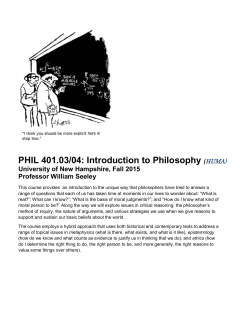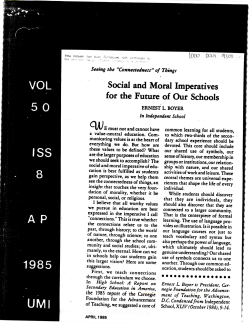
View abstract
The Evolution of Expressivism Why Solving the Frege-Geach Problem and the Problem of Moral Disagreement is not enough The Past - Polarized Positions and Hybrid Theories What is the nature of moral judgments? This question has previously been given two polarized answers. The pure cognitivist argued that moral judgments consist in beliefs which can be true or false. The pure expressivist claimed that moral judgments consist in attitudes which lack a truthvalue. However, neither camp was able to account for the apparent fact that moral judgments have both belief and desire-like features. For example, cognitivists could not explain the apparent practicality of moral judgments. Expressivists, on the other hand, was troubled with how we should think of moral terms in embedded contexts (aka the Frege-Geach problem), and how moral disagreement should be accounted for. Thus, what both sides soon realized was that in order to capture the full nature of a moral judgment they would have to borrow the best features from their opponent. This motivated theorists to widen their explanatory aspirations - hybrid theories started to emerge, focusing on the idea that moral judgments expresses an attitude, or a desire-like state, as well as a descriptive belief. Even though this project seems like a fairly straightforward one, there is a lot of twisting and turning from different philosophers about exactly how these two mental states functions and relates to each other in order to give the best plausible explanation of moral language. Hybrid theories come in different forms - either with an emphasis on cognitivism (e.g. Boisvert, 2008) or expressivism (e.g. Ridge, 2006). What we will focus on in this paper is hybrid expressivism. One problem for hybrid expressivism is that it seems able to solve one of the problems stated above, but not both. For instance, in 2006, Michael Ridge put forth Ecumenical Expressivism, a theory which explained moral judgments as expressing beliefs and general attitudes toward certain properties. However, this solution could only solve the Frege-Geach problem but left the problem of moral disagreement unsatisfied. But if one argues that moral judgments express attitudes towards the subject (Eriksson, 2009), it seems that one can make sense of disagreement, but not the Frege-Geach problem. This puts the hybrid expressivist in a dilemma (Eriksson, forthcoming) - they simply cannot solve both problems at the same time. This motivates a major change in hybrid expressivism, if it ought to have a future in the meta-ethical debate. The Present - Relational Expressivism This is where we are today. Modern theories of hybrid expressivism, what we label as „Relational Expressivism‟, have included features of metaphysical relations (Schroeder, 2013) and specific mental states (what Toppinen (2013) refers to as „higher order states‟) with the aim to be able to solve both the Frege-Geach problem as well as to account for moral disagreement. Nevertheless, we argue that even if the relational expressivist is able to solve previously hard fought challenges, it is burdened with a new problem - the added metaphysical relation or mental state is either vacuous or contradictory. This new problem will be the first of our two concerns in this paper: i) the adding of a new mental state or metaphysical relation entails a unreasonably high ontological cost considering the explanatory gain, and: ii) there are other promising alternatives, which hybrid expressivist could utilize in order to sustain the explanatory value that we seek, that has not been properly investigated. We argue that these new elements introduced in relational expressivism are not explained sufficiently enough in order to safely enjoy the theoretical advantage it is supposed to generate. Our case against relational expressivism is a two horned dilemma: the only interpretations of the relation between desires and beliefs (that in Toppinen‟s case realizes a higher order state) renders it either vacuous or such that it includes too much, causing it to contain contradictions. Our first claim is built from the apparent lack of explanation of what the relation, or higher order state, is really supposed to be - if it can‟t be explained other than by reference to the desires and beliefs it is constituted by, that would render it ad hoc. Our second claim, built from Allan Gibbard‟s argument in Thinking How to Live (2003), states that two agents who accept the same normative claim will also have to accept all the things that this claim „rules in‟. This would entail that a position using the notion of multiple realizability in this instance would be committed to the idea that an agent, when accepting a certain normative statement, accepts contradictory beliefs and desires (e.g. accepting P&¬P at the same time). This argument creates a new requirement for modern hybrid expressivists, that is, they have to provide an account of semantics which is free from contradictions. This takes us to the second concern of this paper. The Future - Food for Thoughts So, in light of this new requirement, is there a better way to approach hybrid expressivism? We believe that there is. In the spirit of Wayne Davis (2003), John Eriksson (2014) has suggested that meaning should not be explained in terms of beliefs, desire-like states, metaphysical relations, or higher order states for that matter. Meaning should be explained in terms of a more basic mental state - thoughts (and its equivalent to desire-like states). This theory satisfies our requirement of a contradictory free semantics stated above, since thoughts are not a „product‟ of beliefs and desirelike states, it is not even necessarily connected to other propositional attitudes (e.g. you can think that Smaug is guarding the gold in Erebor without believing it). However, there are certain matters that need to be attended to before its viability can be fully assessed. The most urgent issue for Eriksson‟s theory, an issue he shares with Toppinen and Schroeder, is its vagueness. What exactly is a thought? What is the relation between thoughts and other propositional attitudes? Is there a metamorphosis occurring such that thoughts transform into other propositional attitudes (e.g. belief, hope, fear etc.)? And, even if we are able to grasp the concept of a thought, is it really plausible that it has a basic counterpart in the evaluative domain? Nevertheless, ceteris paribus, Eriksson‟s use of thoughts seems more intuitive and familiar as opposed to e.g. Toppinen‟s rather mysterious higher order states. Our last aim for this paper is to straighten out some of these question marks in order to show that there is a viable and promising future for hybrid expressivism which can avoid the pressing problems faced by contemporary hybrid expressivists. In conclusion, hybrid expressivism may have hit a brick wall, but „tis not over till the fat lady sings. List of Literature: Boisvert, Daniel. (2008) “Expressive-Assertivism”, Pacific Philosophical Quarterly, vol. 89 (2). Davis, Wayne. (2003) Meaning, expression and thought. Cambridge: Cambridge University Press. Eriksson, John. (2009) “Homage to Hare: Ecumenism and the Frege-Geach Problem”, Ethics, vol. 120 (1). Eriksson, John. (2014) “Hybrid Expressivism: How to think about meaning” in Having it Both Ways: Hybrid Theories and Modern Metaethics (eds.) Guy Fletcher and Michael Ridge. New York: Oxford University Press. Eriksson, John. (forthcoming) “Explaining Disagreement: A Problem for (some) Hybrid Expressivist”. Gibbard, Allan. (2003) Thinking How to Live. Cambridge, MA: Harvard University Press. Ridge, Michael. (2006) “Ecumenical Expressivism: Finessing Frege”. Ethics, vol. 116 (2). Ridge, Michael. (2007) “Ecumenical Expressivism: The Best of Both Worlds?”. Oxford Studies in Metaethics, vol. 2. Schroeder, Mark. (2009) “Hybrid Expressivism: Virtues and Vices”. Ethics, vol. 119 (2). Schroeder, Mark. (2013) “Tempered Expressivism”. Oxford Studies in Metaethics, vol. 8. Toppinen, Teemu (2013), “Believing in Expressivism”. Oxford Studies in Metaethics, vol. 8.
© Copyright 2025









